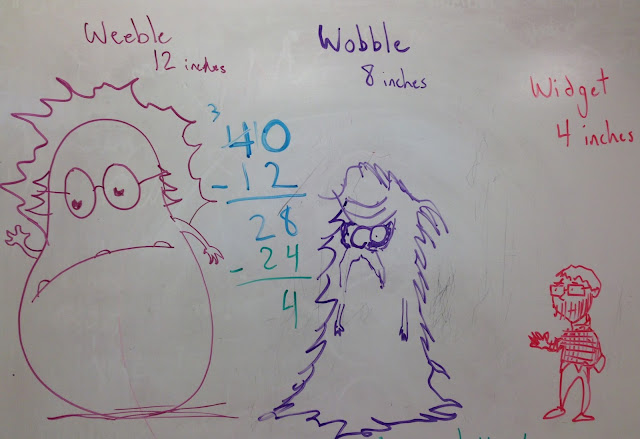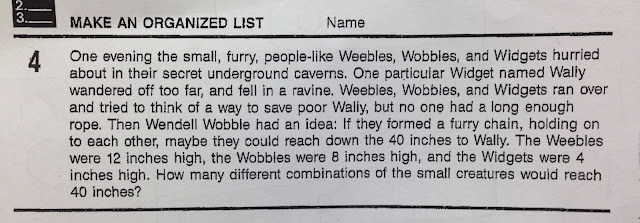 |
| Can you see the patterns emerging? |
As mentioned a couple of weeks ago, Singapore Math is the backbone of our Math program. However, we also do whole-group inquiry and instruction in our Math group. One frequent group activity is using story problems to develop and practice new problem-solving strategies.
One such strategy: Making an organized list.
Here's a recent problem we tackled together, starting out as a group, and finishing individually:
 This type of problem gets kids thinking about a couple of different things. First of all, it quickly drives home the importance of devising some sort of methodical system for keeping track of your work. You can attempt to do this sort of problem in your head, but you will quickly find that you are either repeatedly coming up with duplicate combinations (actually, they're permutations, but we'll get to that in another lesson), or that you're missing some entirely.
This type of problem gets kids thinking about a couple of different things. First of all, it quickly drives home the importance of devising some sort of methodical system for keeping track of your work. You can attempt to do this sort of problem in your head, but you will quickly find that you are either repeatedly coming up with duplicate combinations (actually, they're permutations, but we'll get to that in another lesson), or that you're missing some entirely.
Instead, it becomes necessary to document your work, and to attempt to do so in an organized manner. In this case, we started by making a chart listing the fish costs, then methodically working from largest numbers to smallest:
Using the Glass Fish as our basis, we can see a pattern emerging with the remaining numbers in each permutation. Can you see it? (Within each set of numbers for the Glass Fish, the Gouramis go down by one. Once you've populated your chart to a certain point, you can begin to notice patterns, which can inform the choices that you try. We did this problem largely together as a whole group. Kids have since had opportunities to try similar problems on their own. Here's another that suggests that you should employ the same strategy ("make an organized list").
 |
| Kids almost always buy in when there are goofy drawings involved. |
Here, we see the Weebles, the Wobbles, and the Widgets, all working together to rescue poor Wally Widget. (An aside: Before passing this out, I stressed that I want them to become confident problem-solvers in real world math situations. Then I gave them this problem, which is patently absurd. They laughed.)
 |
| And here they all are working together. |
Here's how we all got started,
...and here are some final results:
The more we've practiced, the more consistently kids have been able to spot patterns early in a problem, then use them to solve them.






No comments:
Post a Comment